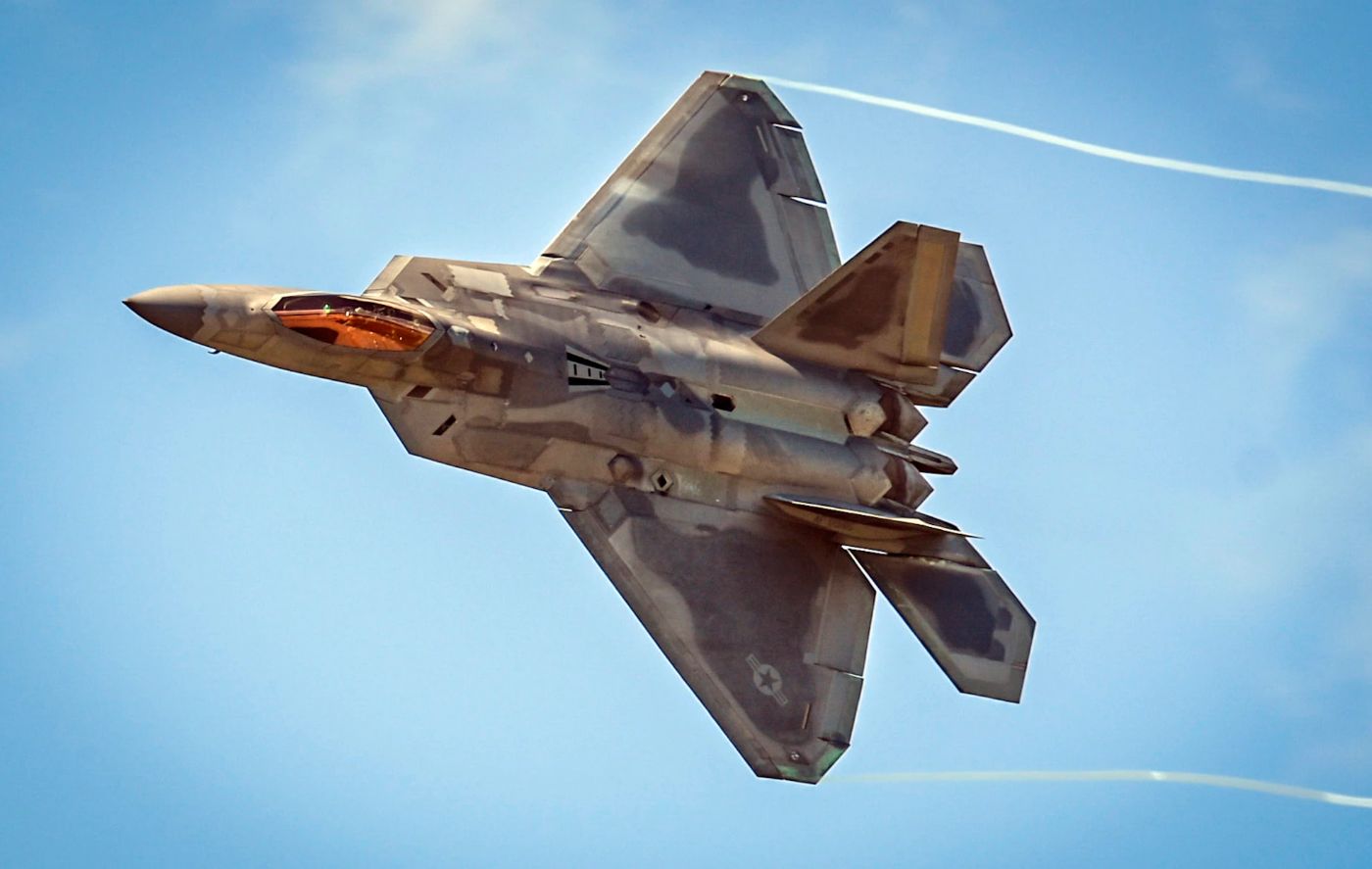With its production halted and a next-generation replacement under development, the F-22 Raptor is nearing retirement. However, its new stealthy external fuel tanks and underwing sensor pods suggest that the aircraft is not done serving the US Air Force yet.
A set of photographs posted by @Task_Force23 on X recently showed the F-22 Raptor in what seemed to be an all-new configuration. The aircraft was spotted flying near Mojave Air and Spaceport, with experts predicting that it was a Raptor, most likely from Edward Air Force Base.
The Raptor was spotted with two InfraRed Search and Track (IRST) system housing pods and two fuel tanks, resembling the concept image of the aircraft shared over two years ago by Gen. Mark Kelly, the head of the United States Air Force’s Air Combat Command.
In January 2022, reports suggested that the F-22 would receive these new transformative capabilities to bolster its combat prowess. The budget line books from the time also stated that the F-22 would receive new fuel tanks and pylons that would be more cost-effective and stealthy than their 600-gallon predecessors.
Raptors and other stealth aircraft are built to fly without external fuel or weapons tanks to maintain a low profile. However, engaging in combat over the vast Pacific, for instance, would necessitate the Raptor carrying more fuel than its internal reserves permit.
Cropped into oblivion but this is the first time I've seen the LO fuel tanks and pods on the F-22 https://t.co/CpqnouNYO8 pic.twitter.com/srOgbeht1e
— TaskForce23 (@Task_Force23) March 22, 2024
The F-22 has long had 600-gallon tanks fitted. The primary problem is that the attachment surface is not smooth when released for dogfighting, which reduces the F-22’s radar cross-section and makes the plane less stealthy when carrying it.
The Air Force’s fiscal 2023 budget request referred to the additional fuel tanks as the Low Drag Tank and Pylon system (LDTP), which the USAF described as a “critical capability” for maintaining air dominance. The F-22’s range, the request pointed out, is increased with the extra tanks and pylons without sacrificing its “lethality and survivability.”
It has long been argued that these new capabilities will allow F-22s to fly supersonically while remaining stealthy, but they can also be discarded using “smart rack pneumatic technology,” resulting in a stealthy-smooth surface.
Having external fuel storage would allow the Raptor to carry additional large sensors or communications systems, further bolstering its capability.

When the artwork was unveiled in 2022, an ACC spokesperson said, “We need every combat platform to go farther, sense farther, and shoot farther. This illustration is simply an artist rendering of an F-22 aircraft with any number of future capabilities.”
Besides the external storage, the F-22 was also seen sporting an infrared search and track (IRST) system. One of the best ways to engage radar-wicking stealth fighters is to use IRST, a passive method of identifying and locating hostile aircraft.
IRST systems, as the name implies, detect heat signatures, enabling a stealth fighter such as the Raptor to seek out opposing aircraft without announcing its presence via radar signals. Additionally, it enables a fighter to use the heat from their exhaust to lock onto stealth enemies.
Since the Raptor’s introduction into service, the Air Force has prioritized equipping the F-22 with an IRST pod. This technology is crucial for identifying an enemy whose radar cross-section has been reduced. This becomes even more significant when preparing against a technologically advanced adversary like China.
These upgrades are believed to act as a bridge between the Raptor and the Next Generation Air Dominance (NGAD) platform, which is expected to get into service by the end of the decade and replace the Raptor.
Raptor Nears Retirement But Remains Indispensable
Current plans call for the USAF to purchase 200 crewed Next Generation Air Dominance (NGAD) aircraft, which will replace the fleet of about 180 F-22s.
However, until that happens, the most lethal air-to-air fighter in the world will need to be more powerful than ever to take on the numerous and quickly expanding new threats that it will face until the NGAD is inducted.
Last year, the US Air Force requested to retire 32 Block 20 F-22s as part of its fiscal 2024 budget so that the money spent on their upkeep could be diverted to the NGAD. The Block 20 F-22 jets are early production models primarily designed for training purposes and are not combat-capable.
Congress obstructed the plan to send the 32 Raptors to the boneyard despite the service’s justified arguments in favor of junking them.
The US Congress has blocked the US Air Force’s request to scrap the 32 old Block 20 F-22 Raptors. “F-22 is a critical capability,” Air Force Acquisition Chief Andrew Hunter said. “So what’s my highest priority in the near term for that great power competition? I’d probably put F-22 at the top.”
Hunter went on to say that Air Force representatives will talk to Congress about “some” F-22s that aren’t combat-ready, and it seemed as though money might be better spent updating other Raptors in the fleet.

Later on in the day, Air Force Chief of Staff Gen. David Allvin declared that the service’s current goal was to keep a few F-22s “viable and relevant against the threat until Next Generation Air Dominance” arrived.
These statements indicate that even if the USAF is unable to junk the older F-22 Raptors, it has decided to focus on the more advanced Block 35 F-22 Raptors to prepare itself for a potential future conflict.
The need to further boost the combat capability by extending the range and introducing sensors may be influenced by the need to keep the F-22s combat-capable and in the fight.
Additionally, the F-22 is being used to test some of the technology for the incoming NGAD. And they will likely use this technology developed for the NGAD family of systems, as previously reported by the EurAsian Times.
Given that it was created in the 1980s, improved in the 1990s, and started a brief production run in the new millennium, it is impressive that the F-22 is still as feared as it was at the time of design, even though the aircraft has never really seen any real combat.
- Contact the author at sakshi.tiwari9555 (at) gmail.com
- Follow EurAsian Times on Google News




